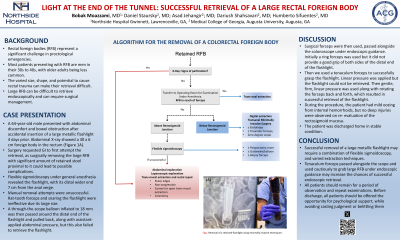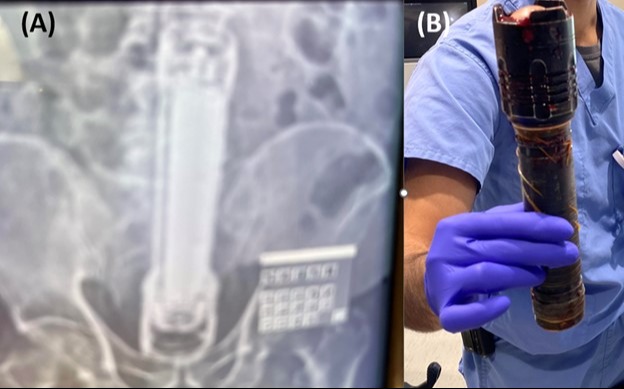Sunday Poster Session
Category: Colon
P0320 - Light at the End of the Tunnel: Successful Retrieval of a Large Rectal Foreign Body
Sunday, October 27, 2024
3:30 PM - 7:00 PM ET
Location: Exhibit Hall E

Has Audio

Bobak Moazzami, MD
Northside Hospital Gwinnett
Atlanta, GA
Presenting Author(s)
Bobak Moazzami, MD1, Daniel Staursky, MD2, Asad Jehangir, MD2, Dariush Shahsavari, MD2, Humberto Sifuentes, MD2
1Northside Hospital Gwinnett, Atlanta, GA; 2Augusta University, Augusta, GA
Introduction: Rectal foreign bodies (RFB) represent a significant challenge in proctological emergencies. Most patients presenting with RFB are men in their 30s to 40s, with older adults being less common. The varied size, shape, and potential to cause rectal trauma can make their retrieval difficult. Large RFB can be difficult to retrieve endoscopically and can require surgical management.
Case Description/Methods: A 64-year-old male presented with abdominal discomfort and bowel obstruction after accidental insertion of a large metallic flashlight 4 days prior. Abdominal X-ray showed a 30 x 6 cm foreign body in the rectum (Figure 1A). Surgery requested GI to first attempt the retrieval, as surgically removing the large RFB with significant amount of retained stool proximal to it could lead to possible complications. Flexible sigmoidoscopy under general anesthesia revealed the flashlight, with its distal wider end 7 cm from the anal verge. Manual removal attempts were unsuccessful. Rat-tooth forceps and snaring the flashlight were ineffective due its large size. A through-the-scope balloon inflated to 18 mm was then passed around the distal end of the flashlight and pulled back, along with assistant-applied abdominal pressure, but this also failed to retrieve the flashlight. Surgical forceps were then used, passed alongside the colonoscope under endoscopic guidance. Initially a ring forceps was used but it did not provide a good grip of both sides of the distal end of the flashlight. Then we used a tenaculum forceps to successfully grasp the flashlight. Linear pressure was applied but the flashlight could not be retrieved. Then gentle, firm, linear pressure was used along with rotating the forceps back and forth, which resulted in successful retrieval of the flashlight. The procedure was long and difficult, lasting an hour. During the procedure, the patient had mild oozing from internal hemorrhoids, but no deep injuries were observed on re- evaluation of the rectosigmoid mucosa. The patient was discharged home in stable condition.
Discussion: This case highlights the challenges in managing RFB. Successful removal of a large metallic flashlight may require a combination of flexible sigmoidoscopy, and varied extraction techniques. Tenaculum forceps passed alongside the scope and used cautiously to grab large RFB under endoscopic guidance may increase the chances of successful endoscopic retrieval. This could possibly avoid more invasive surgical options.

Disclosures:
Bobak Moazzami, MD1, Daniel Staursky, MD2, Asad Jehangir, MD2, Dariush Shahsavari, MD2, Humberto Sifuentes, MD2. P0320 - Light at the End of the Tunnel: Successful Retrieval of a Large Rectal Foreign Body, ACG 2024 Annual Scientific Meeting Abstracts. Philadelphia, PA: American College of Gastroenterology.
1Northside Hospital Gwinnett, Atlanta, GA; 2Augusta University, Augusta, GA
Introduction: Rectal foreign bodies (RFB) represent a significant challenge in proctological emergencies. Most patients presenting with RFB are men in their 30s to 40s, with older adults being less common. The varied size, shape, and potential to cause rectal trauma can make their retrieval difficult. Large RFB can be difficult to retrieve endoscopically and can require surgical management.
Case Description/Methods: A 64-year-old male presented with abdominal discomfort and bowel obstruction after accidental insertion of a large metallic flashlight 4 days prior. Abdominal X-ray showed a 30 x 6 cm foreign body in the rectum (Figure 1A). Surgery requested GI to first attempt the retrieval, as surgically removing the large RFB with significant amount of retained stool proximal to it could lead to possible complications. Flexible sigmoidoscopy under general anesthesia revealed the flashlight, with its distal wider end 7 cm from the anal verge. Manual removal attempts were unsuccessful. Rat-tooth forceps and snaring the flashlight were ineffective due its large size. A through-the-scope balloon inflated to 18 mm was then passed around the distal end of the flashlight and pulled back, along with assistant-applied abdominal pressure, but this also failed to retrieve the flashlight. Surgical forceps were then used, passed alongside the colonoscope under endoscopic guidance. Initially a ring forceps was used but it did not provide a good grip of both sides of the distal end of the flashlight. Then we used a tenaculum forceps to successfully grasp the flashlight. Linear pressure was applied but the flashlight could not be retrieved. Then gentle, firm, linear pressure was used along with rotating the forceps back and forth, which resulted in successful retrieval of the flashlight. The procedure was long and difficult, lasting an hour. During the procedure, the patient had mild oozing from internal hemorrhoids, but no deep injuries were observed on re- evaluation of the rectosigmoid mucosa. The patient was discharged home in stable condition.
Discussion: This case highlights the challenges in managing RFB. Successful removal of a large metallic flashlight may require a combination of flexible sigmoidoscopy, and varied extraction techniques. Tenaculum forceps passed alongside the scope and used cautiously to grab large RFB under endoscopic guidance may increase the chances of successful endoscopic retrieval. This could possibly avoid more invasive surgical options.

Figure: Figure 1(A): Abdominal X-ray showing large flash light in the rectum. Figure 1(B): Flashlight after successful removal from the rectum.
Disclosures:
Bobak Moazzami indicated no relevant financial relationships.
Daniel Staursky indicated no relevant financial relationships.
Asad Jehangir indicated no relevant financial relationships.
Dariush Shahsavari indicated no relevant financial relationships.
Humberto Sifuentes indicated no relevant financial relationships.
Bobak Moazzami, MD1, Daniel Staursky, MD2, Asad Jehangir, MD2, Dariush Shahsavari, MD2, Humberto Sifuentes, MD2. P0320 - Light at the End of the Tunnel: Successful Retrieval of a Large Rectal Foreign Body, ACG 2024 Annual Scientific Meeting Abstracts. Philadelphia, PA: American College of Gastroenterology.
